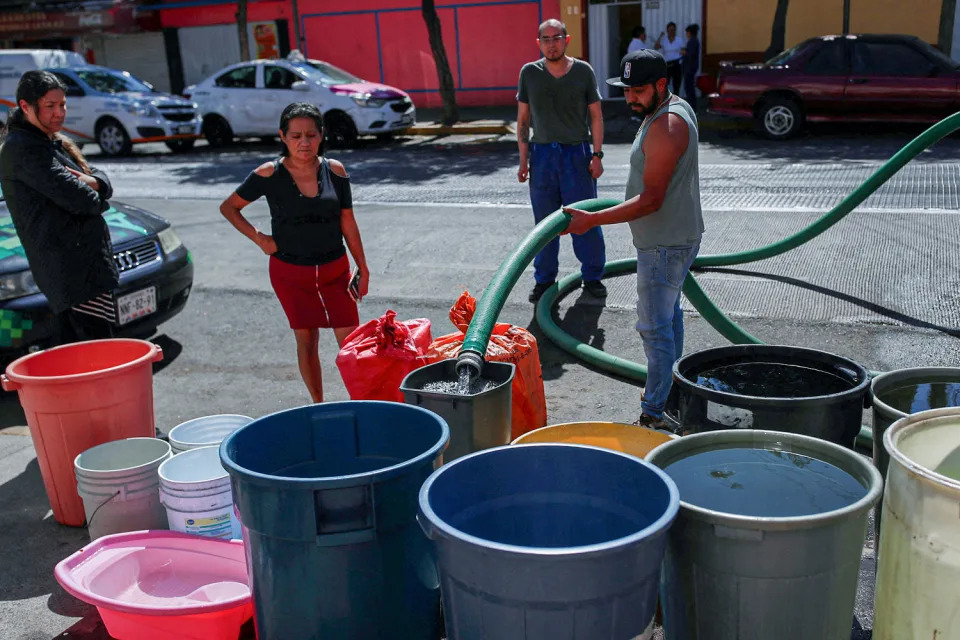The most populous city in North America is in the grips of a severe water crisis, as lingering drought and years of low rainfall push the already-strained system that supplies Mexico City with running water to its limit.
More than 21 million residents across the Mexico City metropolitan area have endured weeks of water shortages, with local authorities imposing rations as reservoirs hit historic low levels.
Olga González, a 50-year-old woman who lives in the neighborhood of Coyoacán, said local officials have been using water tanker trucks to supply water to residents in the area, but there just isn’t enough.
“Sometimes it takes four or five days for the trucks to arrive,” she said.

People fill buckets with water from a water tanker truck in the Azcapotzalco neighborhood in Mexico City on Jan. 26, 2024. (Henry Romero / Reuters)
The shortage means González has to do as much as possible with what little water is available.
“I recycle the water. I go into the shower and collect the water to use it in the toilet,” she said. “And it’s the same with the washing machine. I recycle the water from the wash cycle to use in the toilet.”
She added that she also has to buy drinking water from the store because the water provided by the city is too dirty and chlorinated for consumption.
In Mexico City’s Tlalpan district, Nancy Cabrera Cepeda, a 40-year-old office worker, said that local authorities typically provide residents with water only once a week.
“We have a tank and, when the water arrives it fills up, but in general we have no water supply,” she said.
The shortages have unfortunately become all too familiar for residents of Mexico City, where poorly planned urban development, insufficient infrastructure and the area’s unique history and geography are all taking a critical toll on the region’s water system.
In recent years, droughts intensified by climate change have magnified these ongoing challenges.
“Last year, we spent two months without water,” said Estela Hernández Villa, a 42-year-old merchant who lives in the Iztapalapa district. “There are areas that go even longer without water.”
Darío Solano-Rojas, an associate professor in the earth science engineering division at the National Autonomous University of Mexico, said it’s unlikely that the entire city will run out of water — a milestone that is sometimes referred to as “day zero” — but that the months ahead will likely prove challenging.
“If I run out of water, then for me it’s day zero already,” he said. “This kind of thing has been happening for a long while already.”
The region’s complicated relationship with water is as old as the city itself. Mexico City sits atop a high-altitude former lake bed that was drained in the 16th century after the Spanish conquered the area.
As a result, the city’s main source of water comes from pumping underground aquifers and channeling a network of canals, dams and reservoirs that make up the Cutzamala System.
Roughly 70% of water in Mexico City is pumped from underground, while the Cutzamala System supplies the other 30% to the Mexico City metropolitan area and the nearby Toluca Valley, Solano-Rojas said.
But underground aquifers are becoming stressed as the city rapidly expands, and years of overuse are causing the ground to sink, a process known as subsidence.
A 2021 study co-authored by Solano-Rojas and published in the journal JGR Solid Earth found that groundwater extraction has caused the city to sink at a rate of about 20 inches per year since 1950.
“The city has been growing a lot,” he said. “We have other sources of water but we still get water from underground, so subsidence continues and it’s a problem that hasn’t stopped ever since the construction of the big pyramids in the pre-Hispanic history of the city.”
Local infrastructure has also not kept pace with how quickly Mexico City is expanding, Solano-Rojas said, adding that authorities have been scrambling to repair leaks and replace aging pipes to bolster the region’s water system.
All of these issues are major challenges on their own, but he said that climate change is compounding the water crisis because the region has been suffering from ongoing drought conditions.
TYT Newsroom


